History of the Vienna University Observatory
Beginnings and First Flourishing
The Viennese Mathematical School
In the early Middle Ages, science came to a standstill in Europe, while great breakthroughs in the areas of mathematics and astronomy were being made in the Arabic world. Only the establishment of the new universities (1365 in Vienna) allowed the Occident to catch up.
Since that time, virtually no other scientific subject has been as closely associated with the university as astronomy. As an example, one of the rectors during the 14th century - Heinrich von Langenstein (rector of the University of Vienna in the winter semester of 1393/94) - was not only a theologian, but an astronomer as well.
A first flourishing of Austrian astronomy was brought about by a triumvirate: Johannes von Gmunden, Georg Aunpeckh von Peuerbach, and Johannes Müller von Königsberg, called Regiomontanus. Johannes von Gmunden (1385-1442), Canon of St. Stephan, occupied himself with the observation of planets and the development of instruments as well as the science of calendars. His successor Peuerbach (1423-1461) came into contact with scholars of the Renaissance, who had brought antique texts and knowledge with them to Italy, particularly after the fall of Constantinople (1453), in the course of his own travels to Italy. He was thus able, for example, to introduce the use of trigonometric functions to the Occident. His early death prevented the completion of much of his planned work, such as a translation of the Almagest. Some of this planned work would be completed by his highly gifted student Regiomontanus (1436-1476), whose main areas of focus included meteorology, the translation of classical works, the science of calendars, and all other disciplines of mathematical astronomy. One of his works, the ephemerides he published in 1474, made history when Christopher Columbus used them as navigational aids on his journeys of exploration.

From left to right: A view of the Theresian auditorium building of the Old University in Vienna through the flying buttress in the Bäckerstraße (1837), Johannes Müller von Königsberg ("Regiomontanus", 1436-1476), eclipse tables by Regiomontanus (1476).
The Copernican Revolution
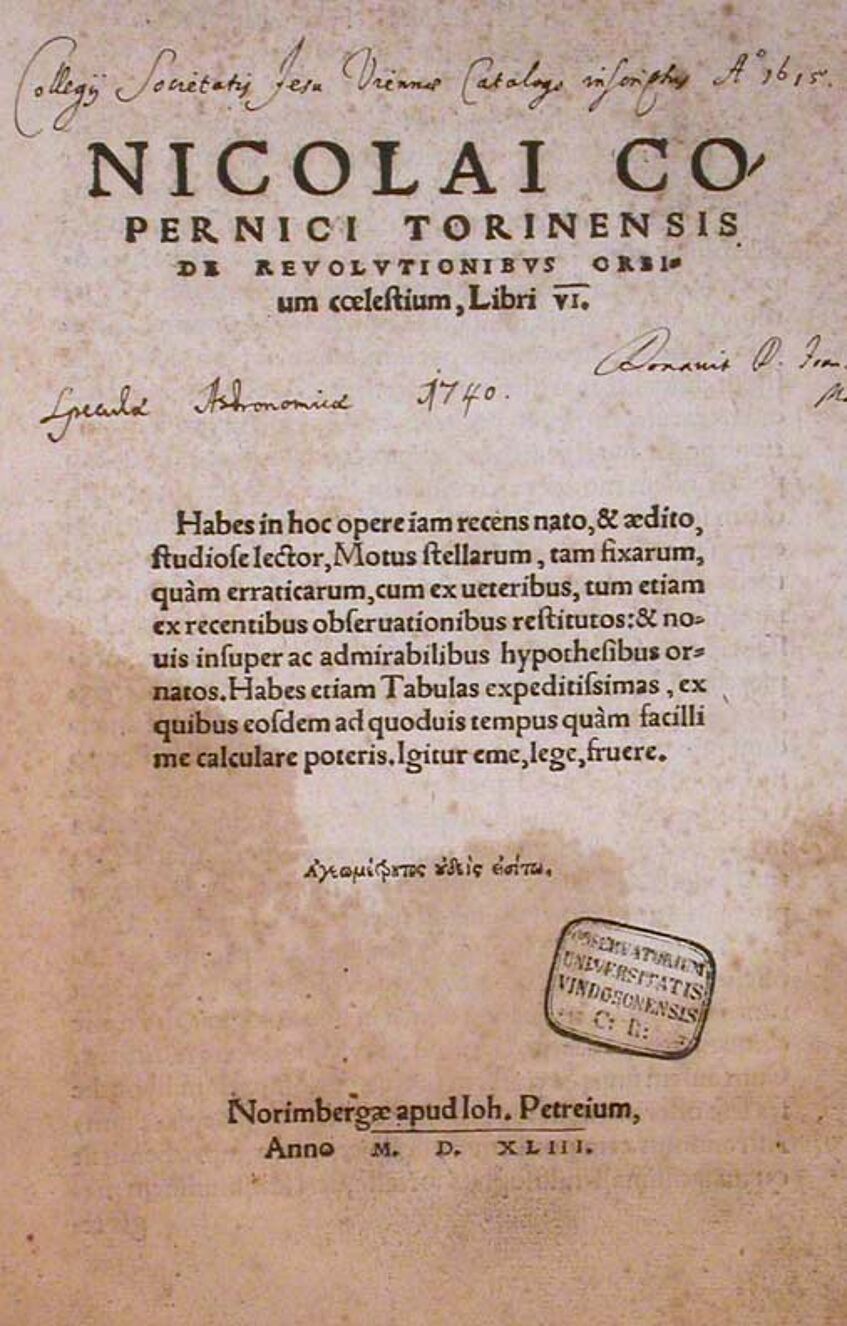
"De revolutionibus orbium coelestium" (1543) by Copernicus, front page
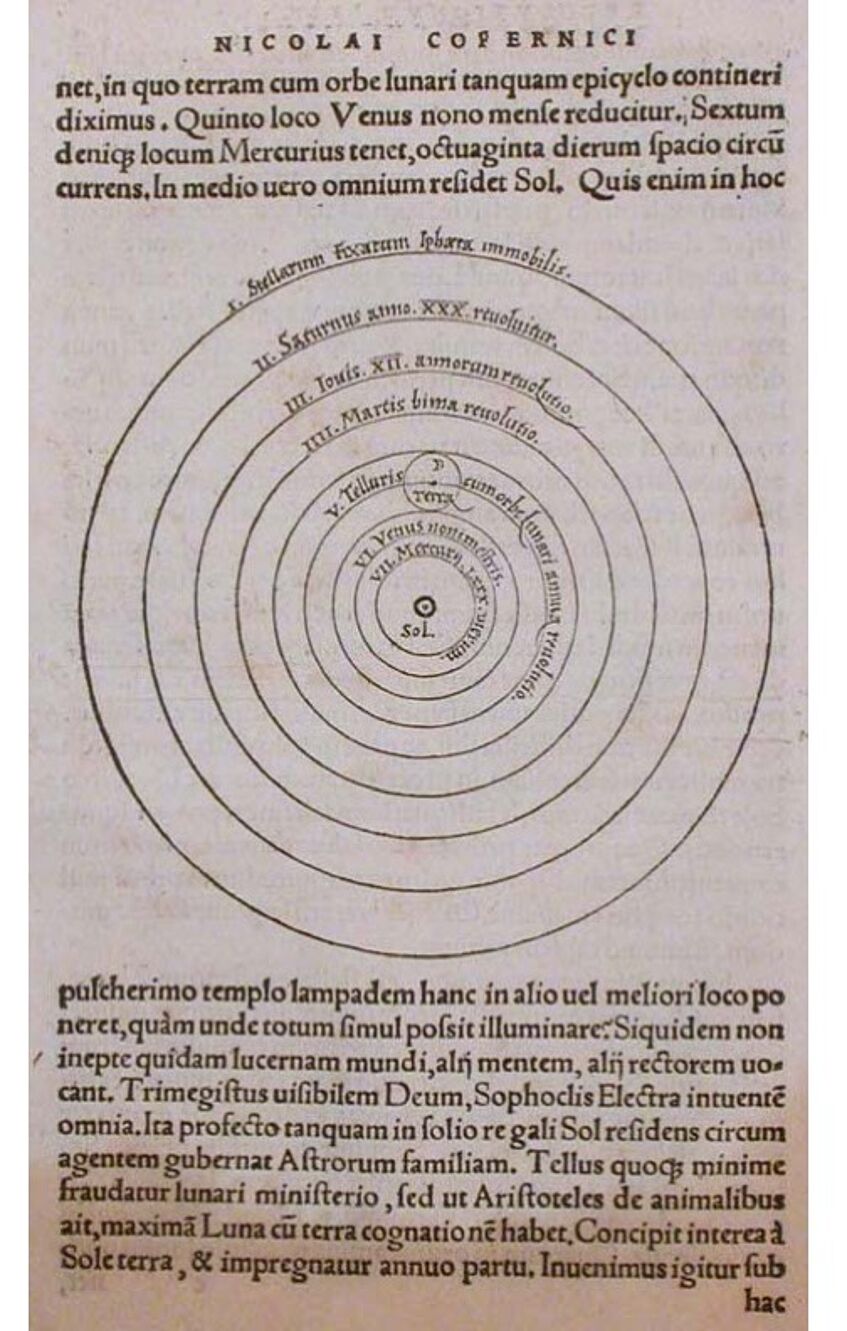
Diagram of the solar system according to Copernicus (from "De revolutionibus orbium coelestium")
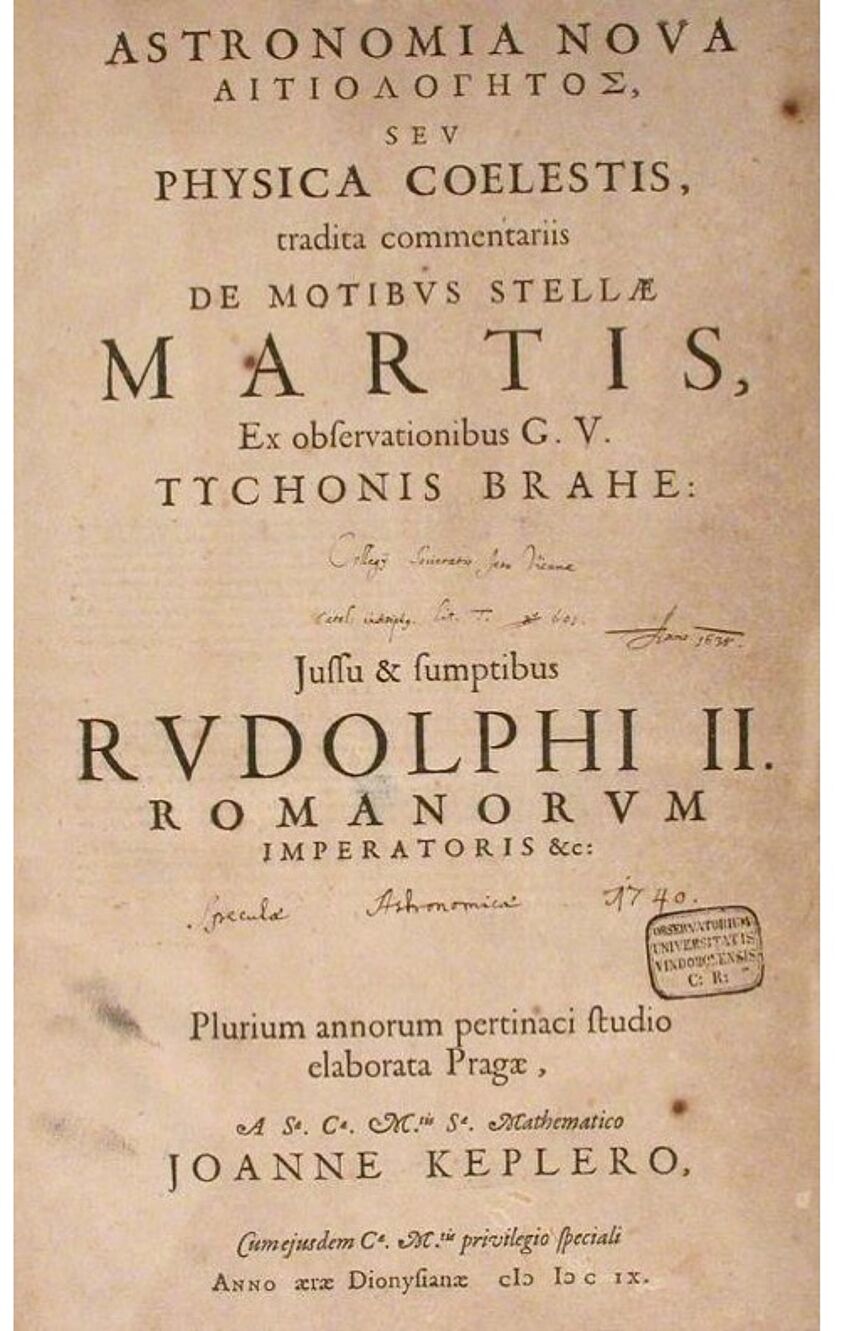
"Astronomia Nova" (1609) by Johannes Kepler
What Regiomontanus anticipated but could not accomplish was achieved by Nicolaus Copernicus (1473-1543), and Johannes Kepler (1571-1630), who also worked in Austria. They proved the validity of the heliocentric model via theory and observational data and, in doing so, laid the groundwork for modern astronomical research. Their most important works are De revolutionibus orbium coelestium and Astronomia Nova, respectively.
The First Observatories in Austria
Marinonis private observatory
Although astronomy had been taught at the University of Vienna since the Middle Ages, there was no dedicated institute featuring a permanent observatory for many years, even into the early 18th century. This finally changed when Johann Jakob de Marinoni (1676-1755), an imperial mathematician born in Udine, built the first observatory in Vienna on the roof of his private home by Vienna’s city wall in 1730.
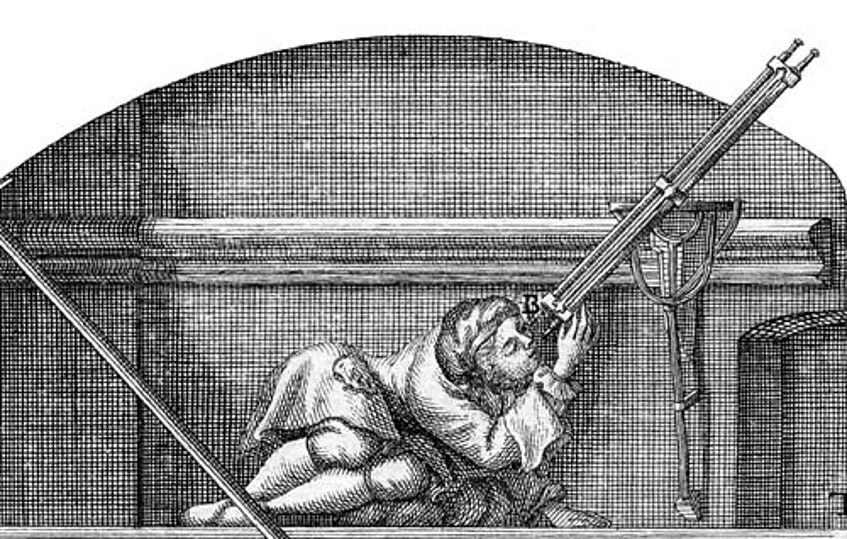
The enthusiastic observer Johann Jakob de Marinoni at (quite uncomfortable) work.

Front page of a detailed description of Marinoni’s private observatory.
The Jesuits’ Astronomical Tower

Academic college in Vienna (1759) - painted by Bernardo Bellotto (called Canaletto). On the right is the academic college (today: Postgasse), at the centre is the astronomical observation tower (observatory, constructed in 1733), to the left the Dominican Church.
Only a few years later (1733), the Jesuit Order constructed its own observatory on the corner of Postgasse and Bäckerstraße in the form of a 45-meter tower. It is thanks to the Jesuits’ lively collecting activity that the present-day university observatory possesses the majority of its most valuable books.
The First University Observatory
In January of 1755, as the construction of the university established by Maria Theresia at the present-day Ignaz-Seipel-Platz (now the Academy of Sciences) was nearing completion, Marinoni died. His instruments were left to the ruling family, and Maria Theresia gifted them to the university. This provided a reason to construct a dedicated observatory on the roof of the university’s auditorium building, the planning of which was carried out by the Jesuits.
The positions of stars were measured with telescopes and sextants pointed out of the windows of the observatory tower. In order to determine the stars’ positions accurately, the most precise possible pendulum clocks were also necessary.

The observatory as a structure built onto the university’s auditorium building, by Jadot
Noteworthy Research Results
The first observatory director, the Jesuit Maximilian Hell (1721-1792), was already held in high regard internationally, especially due to his publication of astronomical almanacs (Ephemerides Astronomicae, 1757-1806), significantly earlier than, for example, the major observatories in Greenwich or Berlin. These contained, among other things, precisely defined positions of the Sun, the Moon, the planets, and the brightest stars. Hell also worked in the field of geographic longitude determination.
The most notable event in his scientific career was, however, the observation of a rare passage of Venus across the Sun, accomplished on the island of Vardoe in the Arctic Ocean in 1769. Using his and other observations of the transit of Venus, Hell calculated the most accurate value for the distance between the Earth and the Sun for many decades.
His successor, Franz de Paula Triesnecker (1745-1817), concerned himself especially with higher geodesy. The two first observatory directors, Hell and Triesnecker are immortalized by two centrally located Moon craters, which are named after them.
The wooden structure on the roof of the university quickly proved to be too light and unstable. Horse-drawn carts and the wind especially served to shake the observatory and reduce the precision of astronomical measurements past the point of usefulness. For these reasons, a desire to relocate the observatory to a more convenient location already began to be expressed in the early 19th century.

From left to right: Maximilian Hell (1721-1792) in Jesuit cloth livery, front page of the report of the Venus transit expedition (M. Hell), an impression of the Venus transit expedition, the Triesnecker crater (25 kilometres in diameter) with Triesnecker grooves which are over 200 kilometres long.
The present-day observatory
A New Attempt

Left: Total solar eclipse on July 8th, 1842.
Right: The site of the new observatory building, 1872
A New Attempt
A new era began in 1819, when Johann Josef von Littrow (1781-1840) became professor of higher mathematics and astronomy at the University of Vienna. Although he was ultimately unsuccessful, he endeavoured greatly to relocate the observatory to the edge of the city. After his death, his son Carl Ludwig von Littrow (1811-1877) took over the provisional direction of the observatory. Right away, in his first year as director, he was able to take advantage of an astronomical sensation: the total solar eclipse of July 8th, 1842, which captivated much of the general population, proved to be the perfect advertisement for new investment in astronomy. In 1872, a plot of land (5.5 ha) on one of the hills of the Türkenschanze was successfully acquired as a building site for the new observatory.
The Largest Observatory in the World

From left to right: Layout of the new observatory, view of the observatory (end of the 19th century), view of the observatory (Drawing by J.J. Kirchner, 1878), the 68 cm refractor (the largest refracting telescope in the world at the time of its construction), certificate of foundation of the new observatory
The foundation stone was laid on July 19th, 1874; the architects of the generously laid out new building were Ferdinand Fellner and Hermann Helmer, both specialists in theatre construction. The building was laid out as a combination of residential and observational tracts in a cross shape, and exhibits unusually large dimensions, even by modern standards: 101 meters long by 73 meters wide (in comparison, St. Stephen’s Cathedral is 108 x 70.5 m). With the installation of the Great Refractor (68 cm aperture and 10.5 m focal length), the largest refracting telescope in the world at the time, as well as its other equipment and facilities, the new observatory represented the international cutting edge of astronomical research. It was Edmund Weiss (1837-1917), the next director, who officially inaugurated the observatory in a ceremony attended by Franz Joseph I on June 5th, 1883.
Post-War Period until 1969
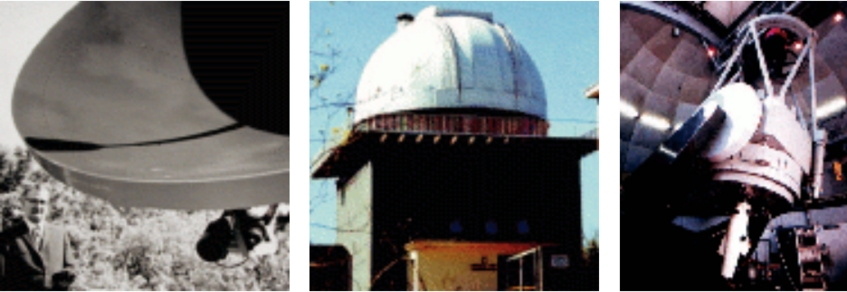
From left to right: Former radio telescope on the roof of the Coudé building, Leopold Figl Observatory for Astrophysics, interior view of the observatory
Post-War Period until 1969
Only the economic upturn during the post-war period made new investment in Austrian astronomy possible again. Step by step, the personnel as well as instrumental situations were improved. Even radio astronomy was carried out from the roofs of the university observatory during the 60s. The highlight of this second upswing period was the establishment of the remote facility on the Mitterschöpfl, the Leopold Figl Observatory for Astrophysics, inaugurated in 1969. Today, it houses a 1.52m and a 60cm reflector telescope.
Internationalisation
There also followed an increased internationalization of astronomical research. Stays at foreign observatories and institutes such as the European Southern Observatory – which Austria joined in 2008 - are just as much a natural part of everyday life as the use of, and even stakes in, space telescopes such as the infrared telescope Herschel.
Even today, the university observatory on the Türkenschanze, or rather the Institute for Astrophysics of the University of Vienna located within it, is a centre for specialized, relevant research in central Europe. The allocation of three professorships in past years also provided a significant contribution. Thanks to additional successes in securing third-party funding, there are roughly 70 positions of employment at the Institute for Astrophysics at the moment.
The current main areas of research range from galaxies in the early universe through star formation and the final stages of stellar evolution to potential “habitable worlds” (planets around other Suns). International cooperation as well as research and development within the frameworks of ESO and ESA are of increasing importance. The Viennese University Observatory is also a centre for astronomical public outreach: more than 2,000 visitors attend the publicly accessible events held at the Institute every year.
Further Reading:
Thomas Posch: Zur Geschichte der Astronomie an der Universität Wien. In: K.A. Fröschl et al. (Hg.): Reflexive Innenansichten aus der Universität. Disziplinengeschichten zwischen Wissenschaft, Gesellschaft und Politik. Vienna University Press 2015, S. 417-428.
